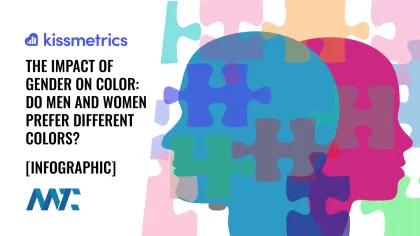
Color plays a crucial role in marketing and branding, with the power to evoke emotions, shape perceptions, and influence consumer behavior. While individual experiences and cultural context are important, research has consistently shown that gender can significantly impact color preferences and associations.
Table of Contents
Understanding these gender-based color tendencies can help marketers and brand managers make more informed decisions when developing visual brand identities and marketing materials.
Gender Differences in Color Preferences
Multiple studies over the past seven decades have revealed notable differences in color preferences between males and females:
Blue Reigns Supreme
Both men and women show a strong preference for blue. In a 2003 study by John Hallock, which polled 232 people from 22 countries:
- 57% of men chose blue as their favorite color
- 35% of women selected blue as their favorite
Blue’s universal appeal may be attributed to its associations with clean water, clear skies, authority, truth, and tranquility.
The Purple Divide
The most significant gender difference appears with the color purple:
- 23% of women chose purple as their favorite color
- 0% of men selected purple as their favorite
Other Notable Preferences
- Green is more preferred by men (14%) compared to women (6%)
- Orange and brown are universally unpopular, but women dislike orange more (33% least favorite), while men dislike brown more (27% least favorite)
Perceptions of Cheap Colors
Interestingly, cheap or inexpensive colors closely align with the least favorite colors for both genders. 26% of all participants viewed orange as a cheap color.
Gender Differences in Color Perception
Beyond simple preferences, research indicates that men and women may perceive and process colors somewhat differently:
Bright vs. Soft Colors
An experiment by Doctors Anya Hurlbert and Yazhu Ling found that while both genders prefer light colors over dark:
- Men gravitate more toward bright colors
- Women prefer softer colors
Tints vs. Shades
The McInnis and Shearer experiment revealed:
- Women prefer tints (colors with white added) more than shades
- Men are more tolerant of shades (colors with black added) and achromatic colors (black, white, gray)
Color Spectrum Preferences
When presented with mixed colors, women tended to prefer shades of pink, which are closer to the red end of the spectrum.
Color Naming Complexity
Women use more specific and varied color names, while men simplify color descriptions. For example, what a man might call purple, a woman might describe as grape, plum, orchid, or lavender.
Implications for Marketing and Branding
While individual and cultural factors are important, marketers can leverage gender-based color insights in several ways:
- Target audience alignment: Consider gender preferences when selecting colors for primarily male or female demographics.
- Balanced palettes: For gender-neutral brands, use a mix of colors that appeal to both men and women.
- Color naming: Use more elaborate color names for female-targeted products and simpler names for male-targeted items.
- Tints and shades: Incorporate more tints in female-oriented designs and more shades in male-oriented designs.
- Testing and optimization: A/B test different color schemes to find what resonates best with your specific audience.
- Context matters: Always consider your brand personality, industry norms, and cultural factors alongside gender preferences.
Beyond Pink and Blue
While gender differences in color perceptions are real, it’s crucial not to oversimplify or rely on outdated stereotypes. The most effective use of color in marketing transcends gender binaries and considers the full complexity of human color experiences.
Successful brands create color palettes that align with their brand personality, resonate emotionally with their target audience, and stand out in their competitive landscape. By understanding gender-based color tendencies as one factor among many, marketers can make more nuanced, strategic decisions about their visual branding.
Ultimately, the goal is to use color purposefully to create a strong brand identity and emotionally resonate with your audience – regardless of gender. With careful consideration and testing, brands can develop color strategies that appeal broadly while still feeling authentic and aligned with their core values.